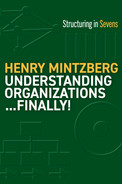PART III
FOUR FUNDAMENTAL FORMS OF ORGANIZATION
The time has come to put the Humpty Dumpty of organizing back together again, or, if you prefer, to return to complete cows. Enough deconstructing the organization into its parts; now we reconstruct these parts into wholes.
If there is no best way to organize, how many ways can there be? Four. To start, at least, in this part of the book. Later we shall consider seven ways, until we will come to the true answer, which is as many ways as we can imagine, under the circumstances. For now, however, we will respect an insight from Yogi Berra, the zany catcher of the New York Yankees baseball team, who, when asked if he would like his pizza cut into four pieces or six, replied: “You’d better make it four, I don’t think I can eat six pieces.” So, for the sake of your digestion, here are four forms of organizations.
There are times when we need to caricature, or stereotype, reality to sharpen its differences and so better understand it. A limited number of forms can help us do that for organizations. The four discussed in this part of the book—constructed from the blocks that we have been discussing—are labeled personal, programmed, professional, and project. More formally, these are the Personal Enterprise (Chapter 7), Programmed Machine (Chapter 8), Professional Assembly (Chapter 9), and Project Pioneer (Chapter 10), shown in the diamond of Figure III.1.
Think restaurants: a corner diner, a fast-food franchise, a gourmet dining room, a catered event—four very different ways of delivering the same service. One revolves around a single person, the owner; the second is fully programmed; the third relies on the skills of its chefs; and the fourth is customized, as a project. In the natural world, compare a troop of monkeys with the alpha male at its head, a flock of geese flying in formation, ants scurrying around doing their own thing together, and a family of beavers building a dam.
Forms like these are known as ideal types—really pure types, since there is nothing ideal about them. Please appreciate that these are not quite reality itself so much as simplifications of reality for the sake of comprehension—although you are likely to find more reality here than you might expect. We will get to the qualifying and the nuancing in due course (Part VI).

FIGURE III.1 The Four Forms
